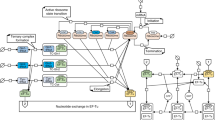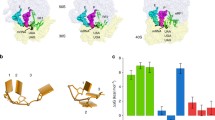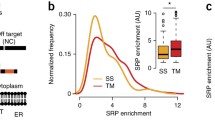Summary
We have compared the competition between strong or weak suppressor tRNAs and translational release factors (RF) at nonsense codons in the lacI gene of Escherichia coli. Using the F'lacIZ fusions developed by Miller and coworkers, UAG, UAA, and UGA codons at positions 189 and 220 were efficiently suppressed by plasmid-borne tRNAtrp suppressors cognate to each nonsense triplet. Introduction of a compatible RF 1 plasmid competed at UAG and UAA but not UGA codons. An RF2 expressing plasmid competed at UAA and UGA but had little effect at UAG. Release factor competition against weak suppressors was measured using combinations of noncognate suppressors and nonsense codons. In each case, release factor plasmids behaved identically towards poorly suppressed codons as they did when the same codons were efficiently suppressed. The implications for these studies on the role of release factors in nonsense suppression context effects are discussed.
Similar content being viewed by others
References
Andersson DI, Bohman K, Isaksson LA, Kurland CG (1982) Translation rates and misreading characteristics of rpsD mutants in Escherichia coli. Mol Gen Genet 187:467–472
Ayer D, Yarus M (1986) The context effect does not require a fourth base pair. Science 231:393–395
Bossi L (1983) Context effects: Translation of UAG codon by suppressor tRNA is affected by the sequence following UAG in the message. J Mol Biol 164:73–87
Capecchi MR, Klein HA (1969) Characterisation of three proteins involved in polypeptide chain termination. Cold Spring Harbor Symp Quant Biol 34:469–477
Caskey CT (1973) Peptide chain termination. Adv Prot Chem 27:243–276
Caskey CT, Scholnick E, Tompkins R, Goldstein J, Milman G (1969) Peptide chain termination, codon, protein factor and ribosome requirements. Cold Spring Harbor Symp Quant Biol 34:479–491
Caskey CT, Forrester WC, Tate W, Ward CD (1984) Cloning of the release factor 2 gene. J Bacteriol 158:365–368
Chang ACY, Cohen SN (1978) Construction and characterisation of amplifiable multicopy DNA cloning vehicles derived from the p15A cryptic mini plasmid. J Bacteriol 134:1141–1156
Edelmann P, Martin R, Gallant J (1987) Nonsense suppression context effects in Escherichia coli bacteriophage T4. Mol Gen Genet 207:517–518
Gallant JA, Erlich H, Weiss R, Palmer L, Nyari L (1982) Nonsense suppression in aminoacyl-tRNA limited cells. Mol Gen Genet 186:221–227
Haseltine WA, Block R, Gilbert W, Weber K (1972) MSI and MSII made on ribosome in idling step of protein synthesis. Nature 238:381–384
Hirsh DI, Gold L (1971) Translation of the UGA triplet in vitro by tryptophan transfer tRNAs. J Mol Biol 58:459–468
Hopfield JJ (1980) The energy relay: a proofreading scheme based on dynamic coperativity and lacking all characteristic symptoms of kinetic proofreading in DNA replication and protein synthesis. Proc Natl Acad Sci USA 77:5248–5252
Kurland CG, Gallant JA (1986) The secret life of the ribosome. In: Kirkwood TBL, Rosenberger RF, Galas DS (eds) Accuracy in Molecular Processes. Chapman and Hall, London, New York, pp 127–157
Lowry OH, Rosebrough NJ, Farr AL, Randall RJ (1951) Protein measurement with the folin phenol reagent. J Biol Chem 193:265–275
Maniatis T, Fritsch EF, Sambrook J (1982) Molecular cloning: a laboratory manual. Cold Spring Harbor Laboratory Press, New York
Miller JH, Albertini AM (1983) Effects of surrounding sequence on the suppression of nonsense codons. J Mol Biol 164:59–71
Raftery LA, Egan JB, Cline SW, Yarus M (1984) Defined set of cloned termination suppressors: in vivo activity of isogenetic UAG, UAA and UGA suppressor tRNAs. J Bacteriol 158:849–859
Ryden M, Isaksson LA (1984) A temperature sensitive mutant of Escherichia coli that shows enhanced misreading of UAG and enhanced efficiency for some tRNA nonsense suppressors. Mol Gen Genet 193:38–45
Scolnick EM, Tompkins R, Caskey T, Nirenberg M (1968) Release factors differing in specificity for terminator codons. Proc Natl Acad Sci USA 61:768–774
Strigini P, Gorini L (1970) Ribosomal mutations affecting efficiency of amber suppression. J Mol Biol 47:517–530
Vijgenboom E, Vink T, Kraal B, Bosch L (1985) Mutants of the elongation factor EF-Tu, a new class of nonsense suppressor. EMBO J 4:1049–1052
Weiss RB, Murphy JP, Gallant JA (1984) Genetic screen for cloned release factor genes. J Bacteriol 158:362–364
Author information
Authors and Affiliations
Additional information
Communicated by K. Isono
Rights and permissions
About this article
Cite this article
Martin, R., Hearn, M., Jenny, P. et al. Release factor competition is equivalent at strong and weakly suppressed nonsense codons. Molec. Gen. Genet. 213, 144–149 (1988). https://doi.org/10.1007/BF00333411
Received:
Issue Date:
DOI: https://doi.org/10.1007/BF00333411




